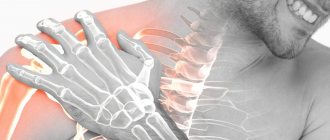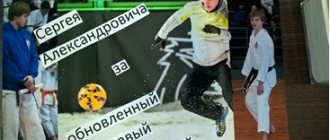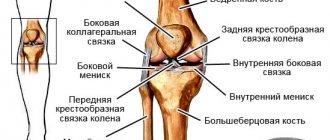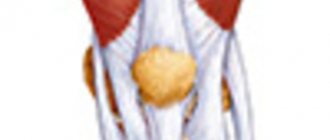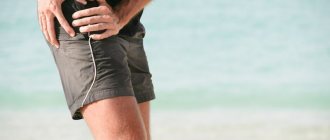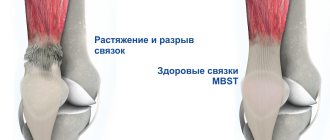Injuries to the ankle and ankle area account for the lion's share of all injuries to the musculoskeletal system. The share of ligament tears in the structure of sports injuries can reach up to 40%. Bruising, damage to the ligaments and bones of the joint can be caused by muscle imbalance, defects in shoes or coverings, changes in the nervous system, or simple inattention. Depending on the extent of damage, the prognosis for recovery can vary dramatically. To understand the principles of care for ankle injuries, it is worth understanding the types of injuries.
Anatomy of the ankle joint
The ankle is one of the large elements of the osteoarticular system that supports the weight of the body. It is formed by the talus, tibia and fibula and serves as a support and is also responsible for movement.
The joint has a well-developed ligamentous apparatus, which allows the foot to perform various movements: flexion, extension, abduction, rotation.
If the joint is damaged, a person cannot walk or step on the foot for a long time.
The structure of the ankle and its functions
The very name of this joint explains its purpose - it connects the lower leg and foot. With increased mobility, the joint provides a person with the ability to move independently. Disruption of this organ leads to loss of the ability to walk. The ankle is most often injured than any other joint, which is why, of all the bruises of the limbs, the most dangerous injury is to the ankle.
This joint consists of two tibia (tibia and fibula), calcaneus and talus bones. Among people less familiar with medical terms, ramming is called “lifting”; this definition is well known not only to football players. Its two sides are covered by the tibia, forming the ankle. The surfaces of the bones at the junctions are covered with cartilage.
Ligaments and muscles keep the bones in the required comfortable position. Ligaments are strong and elastic tendons that wrap around the ankle and secure the joint. The muscles are connected to the joint through ligaments. They themselves are not part of the organ, but play a significant role in its functioning. The picture is completed by a powerful network of blood vessels entwining the joint.
Causes and results of injuries
Bruise from a contusion in the ankle area
The ankle is a complex joint that bears a tremendous load. This joint supports the entire weight of a person and performs many movements in different directions when walking or other actions.
You can twist your foot and damage a joint, pull or tear ligaments simply by walking and stepping on your foot unsuccessfully. The most common causes of injuries in this area are:
- increased load on the ankle as a result of active physical activities: sports, dancing, etc.;
- excess weight (it increases the already significant load on this joint);
- pregnancy (a growing belly increases a woman’s weight, moreover, it can put pressure on veins and arteries and impair blood flow in the lower extremities, which is also a risk factor);
- sudden or unnatural movement;
- fall and impact;
- weakness of the ligamentous apparatus;
- age (elderly women are more susceptible to such injury);
- wearing uncomfortable high-heeled shoes.
Main reasons
Bruise on the leg after a bruise
As a rule, a bruise on the ankle is the result of external forces acting on the leg without compromising the integrity of the bone tissue. The main reasons are a blow and a strong fall.
Most often, an ankle injury causes additional damage to the skin, subcutaneous tissue and blood vessels.
A bruise, in turn, can lead to various complications. Depending on the severity of the injury, a hematoma often develops, bruising and soreness appear.
If the blow was strong, an ankle fracture, tendon rupture, joint or ligament damage, or dislocation are possible.
That is why you should not delay visiting a traumatologist, otherwise hemorrhage and necrotic damage to the lower limb are possible.
Tears and ruptures of ligaments
Tears and ruptures of the ankle ligaments are the most extensive group of injuries. In a typical direction of “rolling” the foot, 1, 2 or 3 lateral ligaments are injured. It is worth noting that the ligaments are characterized by low elasticity. When overloaded, they do not stretch, but break completely or partially. The rupture is accompanied by pain, swelling, and sometimes a crunching or crackling sound. In the future, the ligaments may grow together or lose their tension. Small partial tears with the right approach have a very favorable prognosis. Complete tears of multiple ligaments often lead to chronic instability and re-injury.
Rehabilitation methods
When the pain completely subsides, you can begin rehabilitation measures.
Exercises to develop ligaments and joint gymnastics will help with this. Circular movements of the foot, contraction and pulling on the toe are simple exercises that give quick results. You can go swimming or undergo a massage course to restore tissue integrity and maintain muscle tone.
With a competent approach, there will be no consequences of injury, you can quickly return to a full-fledged daily life without the slightest restrictions.
As a preventative measure, it is advisable to play sports, develop joint flexibility, and monitor weight so that bone, cartilage, and connective tissues do not experience excessive loads every day.
Signs of bruise
An ankle bruise is characterized by injury to the bone, skin, muscles and ligaments. More often, damage occurs as a result of an impact with an object or during a fall, an unsuccessful landing on one’s feet, or during sports activities.
This is due to the fact that in the ankle area there is little subcutaneous fat layer and muscle tissue that protect the bones.
The main symptoms of an ankle injury are:
- Sharp, intense pain in the foot that occurs immediately after injury.
- Limitation of joint movements, lameness, inability to stand or step on the leg.
- Swelling of soft tissues, hematoma, bruise.
- If the nerve vessels are compressed or damaged, the toes may become numb.
Complications
If an ankle injury is left untreated, it can lead to the accumulation of exudate in the joint structure due to the capsule being damaged by the injury. Blood can also accumulate in it, or injury can lead to degenerative processes in the articular joint. In some cases, Sudeck syndrome may be diagnosed, leading to brittle bones and atrophic processes in tissues.
If the joint does not recover and develop for a long time, and the bandage remains on the lower limb, this will lead to muscle atrophy, decreased motor activity and decreased elasticity of the ligaments. Since the tissues remain intact during bruises, many people believe that there is no need to contact a specialist, but in fact, this opinion is wrong. An untreated bruise can lead to serious damage in the future, even with a minor injury. Therefore, if you hang yourself on your ankle, you don’t need to think about what to do and how to treat yourself, but it is better to immediately contact a traumatologist.
The lower limb should be in a bandage or splint for at least ten days. To restore the motor function of the ankle, it is very important to perform therapeutic exercises recommended by the doctor.
When an ankle is injured, it is very difficult to determine what injuries resulted from the bruise. Symptoms include swelling, pain, numbness of the foot and hematomas. Only a doctor can tell exactly what else is damaged using x-rays and feeling the bruised area.
Fractures
Even a small fracture is a potentially serious injury that requires special treatment. The most common types of ankle fractures are:
- isolated fracture of the lateral malleolus,
- bimalleolar fracture,
- bimalleolar fracture with a fracture of the posterior edge of the tibia,
- fracture of the lower third of the leg bones.
To determine the prognosis and treatment tactics, the degree of displacement of fragments and the location of the zone of bone destruction are of great importance. There are fractures without displacement - “cracks” of the bone, and complex injuries with displacement of fragments. Severe fractures can be complicated by ruptures of blood vessels, nerves and ligaments. The outcome largely depends on the correct provision of first and specialized aid, adequate and complete rehabilitation.
Preventing Ankle Injuries
Causes of ankle injuries can include:
- falling from a height,
- traffic accidents,
- industrial accidents
- simple carelessness or carelessness,
- muscle imbalance.
Despite the certain influence of factors beyond our control, the largest percentage of fractures and ruptures of ankle ligaments is associated only with chronic overload and muscle imbalance. Most patients with fractures and severe ruptures recall that before this their foot had already “twisted” several times - the muscles seemed to turn off. Timely restoration of the balance of the muscles of the lower leg and foot is the basis for the prevention of ligament ruptures and ankle fractures. To strengthen the muscular-ligamentous apparatus of the legs, the so-called balance training has proven itself to be excellent. The technique is actively used in sports medicine for training and rehabilitation of football players, gymnasts, and speed skaters. You can carry out balance training at home on a special balancing pillow.
Working with the correct certified balance pillow after just a few minutes gives a feeling of stability, pleasant exercise and massage of the foot and lower leg. Regular exercise leads to stronger ankles and improved balance throughout the body. Very often, various foot deformities lead to ligament rupture. Excessive pronation or supination, heel valgus or varus are corrected with custom orthotics. These products directly correct musculoskeletal imbalances and improve circulation and perception of the foot and ankle area.
First aid
In case of ankle injuries, all possible assistance should be provided using available means.
Procedure:
- Lay the victim down so that the leg is higher than the body level.
- If there is bleeding, stop the bleeding until the blood vessels stop pulsating; a note with the exact time of application is placed under the tourniquet.
- Secure the joint with a splint and apply a bandage.
- In case of severe pain, offer the patient an anesthetic, having previously found out about allergic reactions to drugs.
- Place a cold compress on the injury site for two hours, taking breaks every 10-15 minutes.
- Take the person to the emergency room yourself or call an ambulance.
You should not attempt to straighten a damaged joint, massage it, or apply ointments with a warming effect. The site of injury must be protected from stress and the victim must not be allowed to stand up and lean on his foot.
I twisted my leg, my ankle is swollen: what to do?
No matter how significant the injury, first aid may consist of:
- Fixing the foot with a splint - real or homemade
- You should not step on this foot to avoid causing further harm.
- Apply ice for pain relief. It will also reduce swelling. This compress can be kept for up to 20 minutes without harm to health. Reapply - only after an hour
- If possible, apply a tight bandage
- It is better if the leg is raised.
First aid must be followed by a consultation with a doctor and a determination of the condition of the ankle and entire foot.
How long does it take for a bruise to heal?
The duration of rehabilitation after injury depends on the nature of the damage.
The joint should not be moved, stepped on, or stood for a long time. There are three degrees of damage with different recovery times:
- The first is that sprains and minor injuries can be treated at home. Symptoms disappear within 10 days.
- Moderate degree - the pain does not leave the patient alone, the leg must be rigidly fixed with an orthosis or splint. The minimum duration of therapy is three weeks.
- A serious ankle injury can take six months to heal.
Treatment
It is important to start treating an ankle injury as early as possible. This way we reduce the likelihood of complications and speed up the recovery process.
First of all, you need to perform the following operations:
- Place your lower limbs so that they are higher than your head. This way you can ensure the outflow of blood and synovial fluid. This will prevent the development of hematoma and swelling.
- After lying in this position for about ten minutes, we perform the dressing using an elastic bandage without changing position. This procedure helps prevent the stagnation process from starting again.
- We drink painkillers - Ketorol, Ketanov, Analgin. If there is a qualified person nearby, he can administer an injection of painkillers, for example, Novocaine.
- Apply a compress of ice or an ice-cold piece of meat on top. To avoid getting the bandage wet, it is best to put the cold in a plastic bag.
The rules of behavior during the rehabilitation period are as follows:
- We rest as much as possible. After removing the cold compress, place something soft under the injured ankle.
- We walk as little as possible. If you still have to move, we use a cane or crutch. At the same time, do not forget to put on an elastic bandage first.
- The elastic bandage must be removed before going to bed. We put it on after waking up, after holding our feet above our heads for about ten minutes.
- When bathing, do not use too hot water. A warm bath would be ideal, but it is also unacceptable in the first two days after an ankle injury.
Traditional methods
Treating a bruised ankle at home is not always possible. Sometimes doctors and traumatologists are required not only to diagnose the victim’s condition, but also to provide proper treatment.
In particularly severe cases, doctors may use the following methods:
- Apply an orthopedic fixator. There are a variety of models available to suit injuries. Most are stronger than a regular elastic bandage.
- Sometimes, instead of an orthopedic fixator, a plaster splint is prescribed.
- Non-steroidal anti-inflammatory drugs are prescribed. Warming ointments may also be used.
- They recommend a massage complex after an injury or restorative therapeutic exercises.
- After about a week, physiotherapeutic procedures begin.
ethnoscience
Treatment of a bruised ankle joint with folk remedies should be carried out after the diagnosis has been made. If traditional methods do not work for a long time and the ankle continues to hurt, you need to see a doctor again. Or use traditional medicine methods: painkillers, warming ointments, cold compresses.
We offer the following traditional methods for treating ankle bruises:
- We cut several onions using a meat grinder. We wrap the prepared onion porridge in gauze and use it as a compress. It will work best if taken during the entire night's rest. You can add a little granulated sugar to the onion.
- We use aloe leaves as a compress. To do this, you need to cut them across and place them on the bruised area. Repeat every day for seven days. It is enough to keep such a compress for the ankle for about an hour or half an hour. You can use cabbage instead of aloe.
- Warm up the milk a little. We thoroughly soak a large piece of cotton wool in warm milk. Place it on the bruised area of the ankle. We wrap the top with polyethylene and an elastic bandage, but without tension. You can keep this folk remedy for six hours.
- We heat up the sea salt somehow. We put it in a rag bag and apply it to the area of traumatic injury.
- We take several eggs and extract the protein part from them. Beat well. We collect the top foam and put it on a piece of gauze, which we then use as a bandage. Leave it for the entire night's rest.
- After the previous remedy, we still had some yolks left. You can also make medicine from them. Grind the laundry soap, stir it in a small amount of water until smooth. Add the yolks to the soapy water and beat again. Fold a piece of gauze four times, thoroughly moisten it with the resulting mixture, and use it as a compress.
- This recipe works well in the first hours after injury. Lightly warm half a liter of apple cider vinegar and mix with 2 tsp. table salt, add a few drops of three percent iodine. We thoroughly moisten the gauze folded two or three times, place it on the ankle, and place a cold compress on top. After 20 minutes, remove the treatment and fix the ankle with an elastic bandage, as usual.
Drug therapy
Medicines will help relieve pain and inflammation.
For traditional treatment of a bruised ankle bone, medications are prescribed. Properly selected medications help reduce severe symptoms: relieve pain, swelling and swelling. In addition, they promote rapid recovery, help improve blood flow and strengthen bone tissue.
You should take medications on the recommendation of a doctor; many of them have contraindications and side effects. Usually tablets and local remedies in the form of ointments and gels are prescribed.
Drugs
For therapeutic purposes, the following groups of drugs are prescribed for ankle injuries:
- Nonsteroidal anti-inflammatory drugs are characterized by complex effects. They help cope with severe pain, inflammation of soft tissues and reduce swelling. Such drugs are effective, but can cause side effects and are not suitable for everyone. Therefore, they should be taken after the appointment of a traumatologist. Diclofenac and Nimesulide are considered effective.
- Anti-inflammatory - aimed at suppressing inflammatory processes, as a result of which redness is reduced and swelling is slightly reduced. They are a type of NSAID and are also prescribed by the attending physician. Representatives of Ibuprofen, Piroxicam, Amizon.
- Decongestants - with their help you can remove swelling of the leg in the ankle after an injury and speed up the healing process. Available in the form of tablets - diuretics and in the form of ointments. L-lysine escinate, Troxevasin ointment and others are considered effective.
- Venotonics help restore blood flow, preventing the development of atrophy. It should be used on the recommendation of the attending physician. They are available in various forms; among the tablets, Troxerutin, Diosmin, and Vasoket are considered the most effective.
- Vitamin complexes gr. B - have a positive effect on the hematopoietic system, preventing the development of stagnation. Available in the form of capsules and tablets, it is enough to take once a day. Prescribed by a doctor.
Ointments
Ointments help to quickly relieve swelling.
Local remedies also have analgesic, anti-inflammatory and anti-edematous effects. In addition, to accelerate tissue healing, the doctor prescribes a special group of agents to enhance regeneration.
Well proven:
- Troxevasin is an effective ointment that strengthens the walls of blood vessels. Helps improve blood circulation, thereby reducing swelling of the limb and reducing pain. The drug has few side effects: it is contraindicated in gastrointestinal pathologies, pregnancy, individual intolerance and for young children.
- Lyoton is a local remedy for external use. The ointment is available in packages of 30, 50 and 100 g. The main pharmacological property is to improve blood flow and prevent thrombosis. With its help, it is possible to treat a bruised limb, since the medicine reduces inflammation and normalizes the functioning of blood vessels in the affected area, which promotes accelerated tissue healing.
- Rescuer is an effective ointment for injuries, blows, and sprains. It is also used after a bone fracture with or without displacement. It has an analgesic, anti-inflammatory effect, and stimulates the regeneration process. The composition is based on natural ingredients, so the drug has few contraindications and almost no side effects.
Consequences
Severe bruises are fraught with the development of complications:
When a joint is injured, blood may accumulate in the capsule - hemarthrosis. Severe hemorrhage is an indication for puncture, after which anesthesia with Novocaine is performed.
If you do not consult a doctor in a timely manner, there is a risk of inflammation of the joint and the development of synovitis with the accumulation of excess fluid at the site of injury.
After a few years, if left untreated, the old damage becomes the cause of arthrosis or arthritis.
An ankle injury can lead to Sudeck's syndrome - a change in the blood supply to the joint with trophic disorders of the surrounding tissues, as well as osteoporosis, which results in limited mobility in the joint capsule.
Symptoms and diagnosis
The very first symptom is a sharp pain at the moment one of the joint zones comes into contact with a hard substance. The pain can come and go, or last for several days. The bruise is accompanied by swelling of the soft tissues - this is the second symptom. The presence of swelling means that pain will soon increase, even if it is not felt at the moment.
The appearance of a hematoma in the damaged area signals the appearance of the third symptom. Soft tissues suffer from profuse internal hemorrhage, as a result of which they increase in volume. Their expansion, in turn, leads to disruption of the ligaments. A non-specialist can also predict the appearance of a hematoma; to do this, you need to examine the affected area. If it changes its hue from red to purple in a short period of time, then the bruise is guaranteed to “bloom” further, in the “red-violet-blue-yellow” range.
Loss of sensation in the toes will be a message about the extreme degree of danger of the event. In this case, the nerve endings are damaged much more seriously and the injury can be reclassified as a ligament rupture or fracture.
If you receive even a minor bruise, the first thing you should do is stop putting pressure on the joint for a while. It’s better to sit down and listen to the sensations in your body. It is a good idea to place the injured leg on an elevation. Ignoring a bruise leads to more severe consequences.
In order not to confuse the symptoms of a sprained/torn ligament or fracture of the ankle joint with a bruise, you should carry out a simple experiment: take off your shoes, and after 15-20 minutes try to put them back on. In the event of a fracture or rupture of the ligaments, this will be impossible due to the occurrence of severe pain.
Consequences of injury and possible complications
A frivolous attitude towards injury contributes to the emergence of more serious complications. Loading the injured area will lead to the following diseases:
- Sprain
Due to the weakening of the strength of muscle tissue, the pressure on the ligaments increases, which cannot withstand double or triple tension.
- Ligament rupture
Undetected ligament sprains will lead to their rupture. In addition to the already identified symptoms, increased pain will be added when bending or turning the foot.
- Ankle fracture
If, after a bruise, acute pain does not go away in the first moments, but increases within half an hour, movement should be completely avoided. The symptoms are the same as for a joint fracture, only immobility of the limb is not immediately diagnosed.
A bruise accompanied by constant pain indicates the extreme seriousness of the situation and is a clear reason to contact a medical facility.
The rehabilitation period for such an injury takes from 1-2 weeks to 1-5 months. This depends both on the severity of the injury and on how the victim reacts to this fact. To the consequences already mentioned above, hemarthrosis (penetration of blood into the joint cavity), synovitis (formation of a purulent area) or osteoarthritis (deformation of cartilage tissue) can be added at any time.
- When hit, it is quite possible to get an ankle sprain - the main symptoms and treatment of a sprained ankle joint;
- Also, do not forget that if you hit the ankle joint, a knee dislocation is possible.
Physiotherapeutic activities
A plaster splint is applied to the injured leg for bruises accompanied by the formation of cracks in the bones, ruptures of ligaments, tendons, and muscle fibers. In these cases, physiotherapy is carried out several weeks after removal of the immobilizing bandage. When diagnosing a common ankle bruise, victims are advised to wear elastic or semi-rigid orthoses. They are easily removed, so physiotherapeutic measures begin immediately after the inflammatory process has stopped. Which procedures are most effective:
- laser therapy, which accelerates the resorption of edema, small and large hematomas;
- UHF therapy, which increases the metabolic rate, promotes the removal of tissue breakdown products and the inflammatory process;
- magnetic therapy, which strengthens the walls of blood and lymphatic vessels, accelerating blood circulation;
- electrophoresis with NSAIDs, analgesics, anesthetics to relieve pain, swelling, inflammation;
- diadynamic currents that reduce the severity of pain;
- applications with paraffin, ozokerite, bischofite, eliminating the deficiency of nutrients and biologically active substances in damaged joint structures;
- therapy with therapeutic mud and mineral waters, stimulating tissue regeneration.
Ultrasound therapy of the ankle joint.
But most often, patients with bruises are shown several sessions of cryotherapy. Ether, chloroethyl, liquid nitrogen, and ammonium nitrate are used as refrigerants. During the procedure, the excitability of nerve fibers decreases and their conduction is partially blocked. Reflex muscle spasm is eliminated, pain intensity decreases 5 minutes after using refrigerants.
Preventing ankle injuries
To prevent injuries to the lower extremities, the following rules should be followed:
- Wear comfortable, stable shoes for the season made from natural materials.
- Perform exercises regularly to develop and strengthen the joint.
- Take walks in the fresh air more often, in the summer, walk barefoot on grass, small pebbles, and sand.
- Balanced nutrition with the introduction of fresh vegetables, fruits, vitamins and mineral complexes into the daily menu.
- If chronic diseases occur, timely treatment by a doctor.
- Comply with safety precautions at home and at work, and while playing sports, secure the joint using special protective equipment.
Ankle injury is a problem that, if not treated in a timely manner, leads to serious consequences. To avoid complications, you should listen to the doctor’s recommendations and overcome the disease as soon as possible.
Treatment of ankle pain from the outside and inside
If a fracture is not detected, the patient is prescribed an anesthetic and anti-inflammatory, fluid is removed from the joint, and a splint is applied. Once the ligaments have healed, the limb is developed through exercises and physical therapy. In case of fractures, the leg is fixed with a plaster cast; you can only move with the help of crutches. All parts of the joint must be immobilized; plaster is excellent for this purpose.


